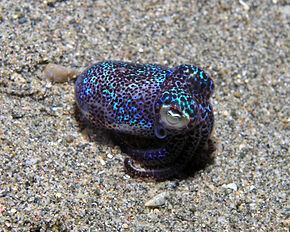Superorder Decapodiformes Rank Species | Subclass Coleoidea Order Sepiolida | |
 | ||
Similar Euprymna, Bobtail squid, Sepiolidae, Sepiola, Sepiadariidae | ||
bobtail squid euprymna berryi
Euprymna berryi, commonly called humming-bird bobtail squid or Berry's bobtail squid among various other vernacular names, is a species of mollusc cephalopod in the family Sepiolidae.
Contents
Description
The humming-bird bobtail squid is a small sized sepia. Its size varies according to the sex; males are no bigger than 3 centimetres (1.2 in) while the female reaches 5 centimetres (2.0 in) length. The global body aspect is compact and rounded. It possesses eight arms and two tentacles, a pair of small lateral fins on the posterior part of the mantle. The background color of the body is translucent with a large number of tiny dark chromatophores. Those later are widely distributed on all the body from arms, head, ventral and dorsal areas of the mantle, except the pair of lateral fins which only the border with the mantle has chromatophores. The external color of the sepia, as we see it, is like a blend of small dark, electric blue and green dots.
Distribution & habitat
The humming-bird bobtail squid is widespread throughout the tropical waters of the central Indo-Pacific area from the Indonesia to the Philippines. Possible larger distribution that could reach Andaman Islands, the Sri Lanka and the western coast of India (some specimen were collected by scientists in 200-/2007). Euprymna berryi has a benthic way of life, it likes sandy or fine sediments bottom in which it can easily bury itself in case of danger or to rest during day time.
Biology
The humming-bird bobtail squid has a nocturnal activity, during daytime it usually stays buried in its preferred substrate. To hunt its prey at night, it uses a bioluminescent organ located in the gill cavity which just emits enough light not to reveal its silhouette to potential predators. It feeds on mainly small benthic crustaceans.
